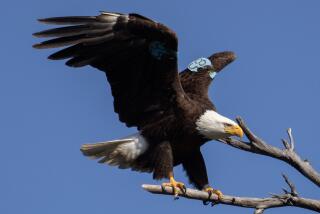BREEDING BIRDS: BURROWING OWL : BURROWING OWL: (Athene cunicularia)
- Share via
Description: The adult burrowing owl is boldly spotted and barred. Long legs distinguish this ground dweller from all other small owls. Its round head and tuftless ears also aid in identification. Habitat: Prefers flat, open land. Diet: Large insects, rodents and lizards. Primarily a nocturnal hunter. Display: Often seen in daylight outside burrow or on fence post, where it bounces and bobs. Nest: This owl adopts abandoned burrows of ground squirrels and other small mammals, occasionally enlarging them by kicking dirt backwards. The nest chamber is usually lined with cow chips, horse dung, food debris, dry grass, weeds, pellets or feathers. Eggs: White and nest-stained, about 1.2 inches long. Natural history notes: In competition with developers for flat, open land, the burrowing owl has lost much of its Orange County habitat and is greatly reduced in numbers. Breeding bird atlas: To report bird breeding activity in your neighborhood, or to get information on the breeding bird atlas (now in its fifth and final year), call Sea and Sage Audubon Society members Sylvia Gallagher, (714) 962-8990, or Nancy Kenyon, (714) 786-3160. Note: Map is divided into 5-kilometer squares so that Audubon Society volunteers can more easily survey areas on a regular basis. Sources: Sea and Sage Audubon Society; “The Birder’s Handbook,” Ehrlich, Dobkin and Wheye, Fireside Books (1988); “Field Guide to the Birds of North America,” National Geographic Society (1987); “Birds of Southern California: Status and Distribution,” Garrett and Dunn, Los Angeles Audubon Society (1981). Indicates 5-kilometer-square areas where breeding activity has been confirmed.
More to Read
Sign up for Essential California
The most important California stories and recommendations in your inbox every morning.
You may occasionally receive promotional content from the Los Angeles Times.












